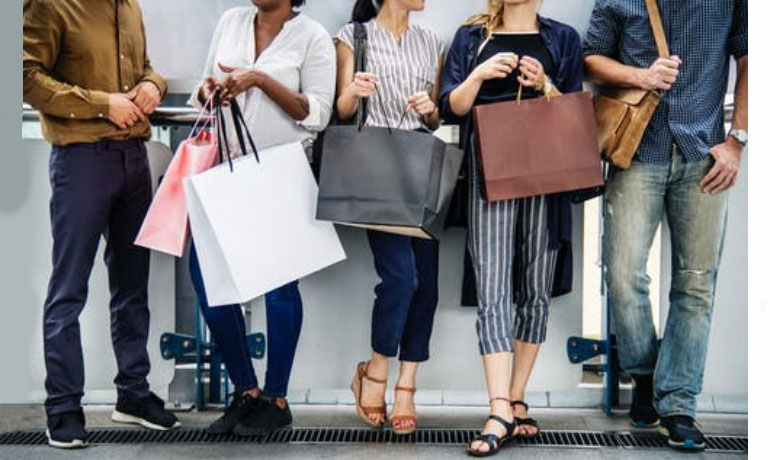When an image from a fashion brand touting a model wearing a matching mask with the outfit made the media rounds, it started a huge debate. Why not?
Asked many online.
It was a part of our new normal now (and perhaps, a necessary part of the wardrobe to remain for a while). A greater conversation amongst an online group led to what would the new normal now lead to.
Especially in terms of emerging trends and the movement towards sustainable fashion as well as the future of the fast-fashion business model.
COVID-19 and its impacts on the world economies seem to have changed world patterns, especially as far as consumer behaviour affecting the world’s most coveted industries; one such industry, in particular, is the fashion industry.
Fast fashion is simply defined as “inexpensive clothing produced rapidly by mass-market retailers in response to the latest trends.”
Marked by auspicious occasions and festivals, the fast-fashion business was thriving in this particular region as retailers could pick up on these occasions and bring forth a collection, which yields high profits and had become quite a lucrative business to be in. It is noted that fast fashion brands have nearly as much as 52 “micro-seasons” a year; each changing new collection means the discarding of the old within a short period to update oneself.
One can only imagine the environmental impact the rapid production creates (as well as wastage). Most of the old collection is not re-utilised but discarded by the purchaser when the trend updates. However, 2020, as a year, has only served up surprises in the first quarter; putting a hold on earnings for many industries, such as travel, hospitality and, particularly, the fashion industry.
With COVID-19, the changes in our lifestyle have been a very daunting but vital process. So daunting that even with a lift of the lockdown here, a great segment of the people preferred the staying-at-home policy. With groceries now being delivered to the doorstep to emerging patterns of workplaces, now switching to digitisation and work from home methods, those who can avail the facilities of staying at home in the continuation are choosing to do so. With consumer behaviour greatly affected, some feel that the change in consumer patterns are a temporary fix. However, the overall impact of COVID-19 has certainly changed the way the world looks, acts and feels. Studies are emerging that the way people buy is going to be very different even post lockdown. The novel coronavirus is going to affect economies in ways that will be felt for years to come. This will include our choices in purchasing in particular spending on luxury goods.
Ease of lockdowns has shown a burst in buying but that is a spike in the graphs only because there was an opening in that period. With millions being laid off work, there were barely any resources or even the mood or willingness to buy what most consider a luxury item.
 In multi-market research on consumer behaviour, data showed that the number of consumers who delayed a purchase has risen since the pandemic hit (Global Web Index). This was especially evident with clothing, home appliances, luxury travel and vacations with clothing being the topmost purchase delayed. The study also markedly showed that the number of people withholding on purchases was increasing; not decreasing. Globally, people are showing signs of concern and yes, saving for the future. Commodities that are considered luxury expenses are certainly being bypassed.
In multi-market research on consumer behaviour, data showed that the number of consumers who delayed a purchase has risen since the pandemic hit (Global Web Index). This was especially evident with clothing, home appliances, luxury travel and vacations with clothing being the topmost purchase delayed. The study also markedly showed that the number of people withholding on purchases was increasing; not decreasing. Globally, people are showing signs of concern and yes, saving for the future. Commodities that are considered luxury expenses are certainly being bypassed.
In light of the changing world trends with the advent of COVID-19, the World Economic Forum (WEF) recently found some very educational findings. Sustainable fashion research details how people will be more likely to choose a more streamlined and basic wardrobe shortly. The global trends and research are certainly pointing towards those with given resources, who would in the future opt to choose garments based on practicality and quality rather than quantity. A key feature during this period, which is coming up now more than ever is the future of sustainable fashion.
With COVID-19, the changes in our lifestyle have been a very daunting but vital process
Sustainable fashion is described often as an entire eco-system, taking into account not just the fashion industry, rather the whole system, such as the supply chain network. Starting from suppliers from the raw materials, the production processes to the culmination until the final product at the retail outlets.
The citizens in all sectors, as responsible beings, come into an ecologically aware and justified process where they see to addressing the needs of safeguarding the environmental impact.
With sustainable fashion now very much a topic of discussion, one can ask if the purveyors of fast fashion with the ever-changing displays and the latest collections based on trends now are willing and able to think on those terms collectively. Within the region itself, we have seen news of millions of employees in textile factories that have been laid off work. The lockdowns worldwide have resulted in unsold merchandise and excess stock worth millions which now remains idle around the globe. As unexpected as this economic predicament is, this could be the catalyst for the garments/textiles industry towards rethinking their business models. Perhaps a shift towards sustainable fashion is the next natural step to evolve further. One could eventually think of the switch for not only the greater good but as a natural option to sustain and enhance business models.
One thing to note is that it is true that environmental studies have shown that the textile/garments industry is creating a huge negative impact on the environment. Creating an excess amount of heat emitted from the processes of the different products is one factor while the water usage and wastage during production are on an exceedingly high ratio. Sustainable fashion research shows that a shift would considerably minimise the burden on climate change and be in alignment with the United Nations (UN) Sustainable Development Goals (SDGs) for the future.
The question arises for all of us as stakeholders on planet Earth. Would the propagators of fashion be willing to jump on the bandwagon as early as now and reorganise themselves for the sake of the future generations? One does understand that the switch to a complete sustainable textile or garment industry in a sense will lead to an initial downfall in profit margins and several expenditures. All of these are huge considerations for one of the most loved industries in the world.
The region here, especially Pakistan is renowned for the most beautiful textiles. Fashion houses, however modern, have successfully seeped traditional stitching and craft, simulating a fusion of patterns into the clothing; each new collection sought out by thousands of buyers. One only hopes the industry survives and can keep its integral part not only for the sake of culture and heritage crafts but simultaneously be able to keep up with the changing trends the world is fast moving towards.






